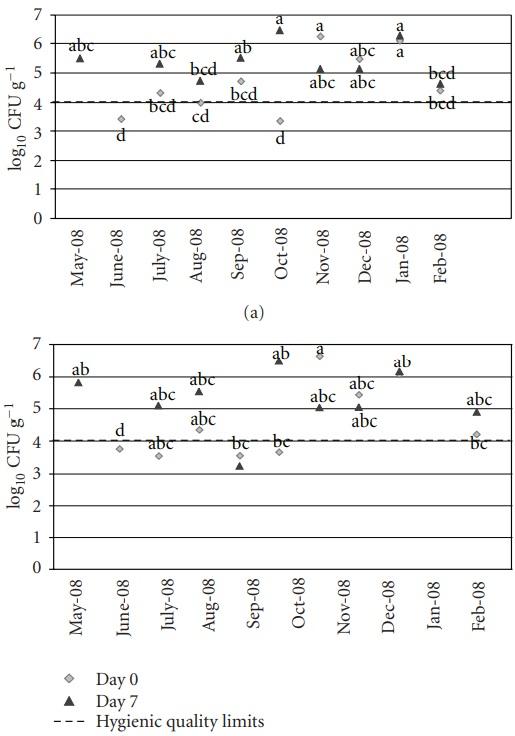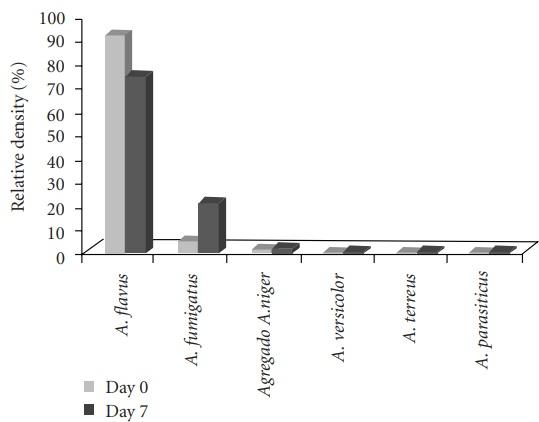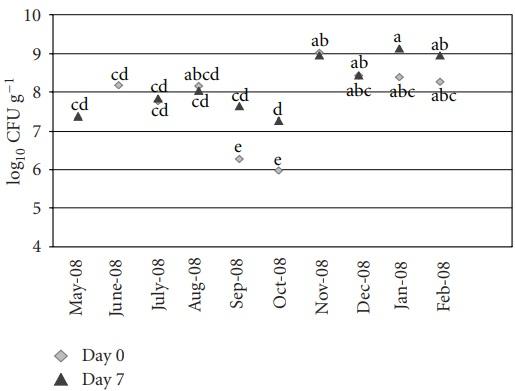Surveillance of Aflatoxin and Microbiota Related to Brewer’s Grain Destined for Swine Feed in Argentina
Author details:









[1] L. R. Cavaglieri, K. M. Keller, C. M. Pereyra et al., “Fungi and natural incidence of selected mycotoxins in barley rootlets,” Journal of Stored Products Research, vol. 45, no. 3, pp. 147–150, 2009.
[2] M. M. S. Simas, M. B. Botura, B. Correa et al., “Determination of fungal microbiota and mycotoxins in brewers grain used in dairy cattle feeding in the State of Bahia, Brazil,” Food Control, vol. 18, no. 5, pp. 404–408, 2007.
[3] B. Kabak, A. D. W. Dobson, and I. Var, “Strategies to prevent mycotoxin contamination of food and animal feed: a review,” Critical Reviews in Food Science and Nutrition, vol. 46, no. 8, pp. 593–619, 2006.
[4] A. Khanafari, H. Soudi, and M. Miraboulfathi, “Biocontrol of Aspergillus flavus and aflatoxin B1 production in corn,” Iranian Journal of Environmental Health Science and Engineering, vol. 4, no. 3, pp. 163–168, 2007.
[5] G. D. Osweiler, “Mycotoxins. Contemporary issues of food animal health and productivity,” The Veterinary Clinics of North America. Food Animal Practice, vol. 16, no. 3, pp. 511– 530, 2000.
[6] C. A. Haskard, H. S. El-Nezami, P. E. Kankaanpa¨a, S. Salmi- ¨ nen, and J. T. Ahokas, “Surface binding of aflatoxin B by lactic acid bacteria,” Applied and Environmental Microbiology, vol. 67, no. 7, pp. 3086–3091, 2001.
[7] G. S. Murthy, D. E. Townsend, G. L. Meerdink, G. L. Bargren, M. E. Tumbleson, and V. Singh, “Effect of aflatoxin B1 on drygrind ethanol process,” Cereal Chemistry, vol. 82, no. 3, pp. 302–304, 2005.
[8] S. Pousga, H. Boly, J. E. Lindberg, and B. Ogle, “Evaluation of traditional sorghum (Sorghum bicolor) beer residue, shea-nut (Vitellaria paradoxa) cake and cottonseed (Gossypium Spp) cake for poultry in Burkina Faso: availability and amino acid digestibility,” International Journal of Poultry Science, vol. 6, no. 9, pp. 666–672, 2007.
[9] Y. N. Yin, L. Y. Yan, J. H. Jiang, and Z. H. Ma, “Biological control of aflatoxin contamination of crops,” Journal of Zhejiang University, vol. 9, no. 10, pp. 787–792, 2008.
[10] G. Capra, A. Echenique, R. Bauza, and H. Petrocelli, “Sistemas de produccion de cerdos en el Uruguay,” ´ Revista del Plan Agropecuario, pp. 47–52, 2003.
[11] Good Manufacturing Practice, “GMP Certification Scheme Animal Feed Sector 2006, Appendix 1. Product standards; regulations on product standards in the animal feed sector,” GMP, vol. 14, pp. 1–39, 2008.
[12] M. A. Klich, Identification of Common Aspergillus Species, Centraalbureau voor Schimmelcultures, Utrecht, Netherlands, 2002.
[13] International Commission on Microbiological Specification for Foods (ICMSF), “Microbiolog´ıa de los Alimentos,” Editorial Acribia. Zaragoza Espana˜ , vol. 1, p. 431, 1996.
[14] J. De Man, M. Rogosa, and M. Sharpe, “A medium for cultivation of Lactobacilli,” Journal of Applied Bacteriology, vol. 23, pp. 130–135, 1960.
[15] P. Sneath, N. S. Mair, E. Sharpe, and J. G. Holt, Bergey’s Manual of Systematic Bacteriology, vol. 2, 1986.
[16] M. W. Trucksess, M. E. Stack, S. Nesheim, R. H. Albert, and T. R. Romer, “Multifunctional column coupled with liquid chromatography for determination of aflatoxins B1, B2, G1, G2 in corn, almonds, brazil nuts, peanuts, and pistachio nuts: collaborative study,” Journal of Association of Official Analytical Chemists International, vol. 77, no. 6, pp. 1512–1521, 1994.
[17] R. Geisen, “Multiplex polymerase chain reaction for the detection of potential aflatoxin and sterigmatocystin producing fungi,” Systematic and Applied Microbiology, vol. 19, no. 3, pp. 388–392, 1996.
[18] G. P. Quinn and M. J. Keough, Experimental Design and Data Analysis for Biologists, Cambridge University Press, Cambridge, UK, 2002.
[19] C. M. Pereyra, L. R. Cavaglieri, S. M. Chiacchiera, and A. M. Dalcero, “Fungi and mycotoxins in feed intended for sows at different reproductive stages in Argentina,” Veterinary Medicine International, vol. 2010, Article ID 569108, 7 pages, 2010.
[20] K. Lyberg, M. Olstorpe, V. Passoth, J. Schnurer, and J. E. ¨ Lindberg, “Biochemical and microbiological properties of a cereal mix fermented with whey, wet wheat distillers’ grain or water at different temperatures,” Animal Feed Science and Technology, vol. 144, no. 1-2, pp. 137–148, 2008.
[21] V. Baliukoniene, B. Bakutis, and H. Stankevicius, “Mycological and mycotoxicological evaluation of grain,” Annals of Agriculture and Environmental Medicine, vol. 10, no. 2, pp. 223–227, 2003.
[22] A. Medina, F. M. Valle-Algarra, R. Mateo, J. V. GimenoAdelantado, F. Mateo, and M. Jimenez, “Survey of the myco- ´ biota of Spanish malting barley and evaluation of the mycotoxin producing potential of species of Alternaria, Aspergillus and Fusarium,” International Journal of Food Microbiology, vol. 108, no. 2, pp. 196–203, 2006.
[23] F. Wang and N. Nishino, “Ensiling of soybean curd residue and wet brewers grains with or without other feeds as a total mixed ration,” Journal of Dairy Science, vol. 91, no. 6, pp. 2380–2387, 2008.
[24] E. M. Bueno, G. Laevsky, and G. A. Barabino, “Enhancing cell seeding of sca ffolds in tissue engineering through manipulation of hydrodynamic parameters,” Journal of Biotechnology, vol. 129, no. 3, pp. 516–531, 2007.
[25] M. P. Mokoena, P. K. Chelule, and N. Gqaleni, “The toxicity and decreased concentration of aflatoxin B in natural lactic acid fermented maize meal,” Journal of Applied Microbiology , vol. 100, no. 4, pp. 773–777, 2006.
[26] A. Hernandez-Mendoza, H. S. Garcia, and J. L. Steele, “Screening of Lactobacillus casei strains for their ability to bind aflatoxin B1,” Food and Chemical Toxicology, vol. 47, no. 6, pp. 1064–1068, 2009.
[27] M. J. M. Batatinha, M. M. Santos, M. B. Botura et al., “Ocorrencia de aflatoxinas emamendoim e seus produtos ˆ comercializados no Estado da Bahia duranteo ano de 2002,” Revista Do Instituto Adolfo Lutz, vol. 62, pp. 183–187, 2002.
[28] A. R. P. L. Bautista, M. Z. A. Oliveira, M. S. Miranda, and L. A. Sales, “Aflatoxinas em graos de milho armazenado no Estado ˜ da Bahia,” Revista Brasileira de Toxicologia, vol. 2, pp. 24–25, 1989.






